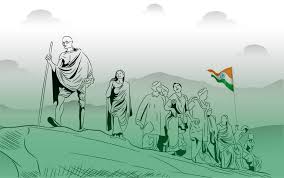11 Aug 2022 Quit India Movement

- On August 8, 2022, India completed 80 years of Quit India Movement, also known as August Kranti.
Introduction:
- On August 8, 1942, Mahatma Gandhi called for the end of British rule and started the Quit India Movement at the All India Congress Committee session in Mumbai.
- Gandhiji called for “do or die” in his speech at Gwalia Tank Maidan, now known as August Kranti Maidan.
- Aruna Asaf Ali, popularly known as the ‘Grand Old Lady’ of the freedom movement, is known for hoisting the Indian flag at the Gwalia Tank Maidan in Mumbai during the Quit India Movement.
- The slogan ‘Quit India’ was coined by Yusuf Mehrli, a socialist and trade unionist who also served as the Mayor of Mumbai.
- Meherali also coined the slogan “Simon go back”.
Cause:
Cripps Mission Failure:
- The immediate reason for the agitation was the termination of the Cripps mission/no final decision on the mission.
Reference:
- This mission was sent under the leadership of Stafford Cripps to solve the question related to the creation of a new constitution and self-government in India.
- Reasons behind the Cripps Mission: Japan’s growing aggression in South-East Asia, the British government’s eagerness to ensure India’s full participation in the war, Britain’s ruling Labor Party due to increasing pressure from China and the United States on Britain the Cripps Mission was sent to India in March 1942 by the Prime Minister of India, Winston Churchill.
Cause of fall:
- This mission failed as it offered Dominion status to India with Partition, not complete independence.
India’s participation in World War II without prior consultation with leaders:
- India’s intention to unconditionally support the British government in World War II was misunderstood by the Indian National Congress.
Spread of Anti-British Sentiment:
- Anti-British sentiment and demand for complete independence had gained popularity among the Indian people.
Centralization of several small movements:
- People’s movements going on for two decades under the leadership of various bodies affiliated to the Congress like All India Kisan Sabha, Forward Bloc etc. had created the background for this movement.
- Militant explosions were taking place at many places in the country which got associated with Quit India Movement.
Shortage of essential commodities:
- The economy was also shattered as a result of World War II.
Demands:
- To get the support of Indians in the Second World War against fascism, there was a demand to end the British rule in India with immediate effect.
- Demand to form an interim government after the British left India.
Phase: The movement had three phases:
- Phase I – marked by urban uprisings, strikes, boycotts and dharnas, which were quickly suppressed.
- There were strikes and demonstrations all over the country and workers provided support by not working in factories.
- Gandhiji was imprisoned in the Aga Khan Palace in Pune and almost all the leaders were arrested.
- In the second phase of the movement, the focus shifted to rural areas which saw a major peasant revolt, with the main objective being to disrupt communication systems, such as railway tracks and stations, telegraph wires and poles, attacks on government buildings or colonial power.
- In the final phase, national governments or parallel governments were formed in different areas (Ballia, Tamluk, Satara etc.).
The success of the movement
The Rise of Future Leaders:
- Leaders like Ram Manohar Lohia, JP Narayan, Aruna Asaf Ali, Biju Patnaik, Sucheta Kriplani etc. carried out underground activities who later emerged as prominent leaders.
Women’s Participation:
- Women actively participated in the movement. Women leaders like Usha Mehta helped set up an underground radio station that created awareness about the movement.
Rise of Nationalism:
- Quit India movement created a distinct sense of unity and brotherhood in the country. Many students left schools and colleges and people left their jobs.
The way to freedom
- Although the Quit India Movement was crushed in the year 1944 and the British refused to give independence immediately, saying that independence would be given only after the end of the war, but due to the burden of this movement and the Second World War, the British administration realized that it was not possible to control India for a long time.
- Due to this movement, the very nature of India’s political dialogue with the British changed and eventually paved the way for India’s independence.
Movement Failure:
Brutal Repression:
- Violence was witnessed at some places during the agitation, which was not pre-planned.
- The movement was violently suppressed by the British, people were fired upon, lathi-charged, villages were burnt and heavy fines were imposed.
- In this way the government resorted to violence to crush the movement and more than 1, 00,000 people were arrested.
Lack of support:
- Muslim League, Communist Party of India and Hindu Mahasabha did not support the movement. The Indian bureaucracy also did not support this movement.
- The Muslim League was not in favor of the British leaving India before partition.
- The Communist Party supported the British, as they were allied with the Soviet Union.
- The Hindu Mahasabha openly opposed the Quit India Movement and officially boycotted it fearing that the movement would create internal disorder and endanger internal security during the war.
- Meanwhile, Subhas Chandra Bose formed ‘Indian National Army’ and ‘Azad Hind Sarkar’ outside the country.
- Many Congress members like C. Rajagopalachari resigned from the provincial legislature because they did not support the idea of Mahatma Gandhi.


No Comments